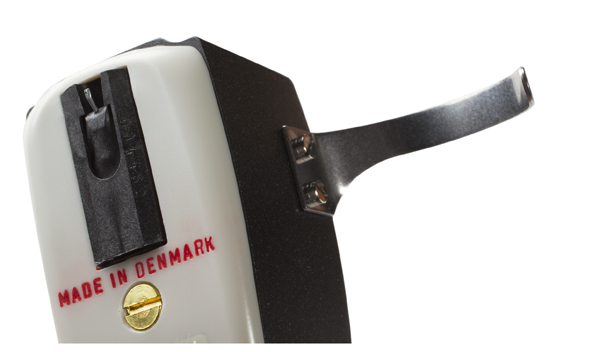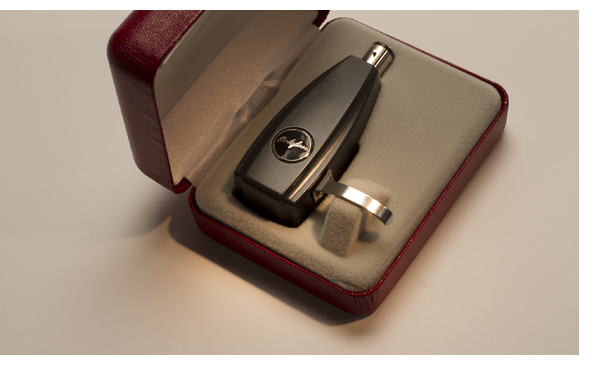Ortofon’s SPU (at least one of them…)
Whether talking about cars, beer, or sneakers, off-the-beaten-path solutions aren’t necessarily for everyone, no matter how cool they might seem. But this one is rather intriguing.
Ortofon’s SPU moving-coil phono cartridge came to life in 1959, designed by Robert Gundmansen (a 50-year veteran of the Ortofon company) as one of the first stereo phono cartridges. SPU stands for “Stereo Phono Pickup.” The model was also one of the first moving-coil cartridges, and originally intended as a broadcast pickup.
The cartridge’s seductive sound quickly made its way to the era’s audiophiles, and represented a perfect fit for SME and other tonearms utilizing a universal headshell-mounting system. The somewhat low-compliance SPU is heavy (30 grams) and includes an integral headshell comprised of Bakelite.
Eight variations on the design currently exist, and three are mono versions. Most share the conical stylus design of the original SPU, but the $999 model reviewed here is the Classic GM E Mk. II, the only entry in the lineup featuring an elliptical stylus profile. It tracks at a fairly heavy 3.5-5 grams. Load to taste somewhere between 100 and 500 ohms, and keep in mind this vintage beauty only puts out .2mv. Hence, those with 58db phonostages will not be able to make optimum use of the cartridge.
 Pick a ‘Table
Pick a ‘Table
If you’re thinking this cartridge would combine fabulously with a Technics 1200, you’re partially correct. However, the SPU’s luscious sound is not the best fit for the dark sound produced by the stock SL1200. Swapping the stock arm for an SME 3009 (akin to the one we’ve had rebuilt and rewired by SMEtonearms.com) is the cat’s meow: The arm provides the subtlety required to extract maximum performance from the SPU.
While publisher Jeff Dorgay uses the SPU with a similar SME arm and AVID Volvere SP turntable, Stereophile columnist Art Dudley actually inspired my obsession. His love for many things vintage and tubey parallels my own, and getting more in touch with the sonic essence of the music made for a great recon mission. The SPU grabbed me at first listen; this is indeed a special sound.
Installed in my SL 1200/SME 3009 ‘table, the integral headshell eliminates most of the set-up anxiety, as only azimuth and tracking force need to be set. The best balance of tracking and high-frequency response occurs at 4.1 grams.
When the Shoe Fits
This cartridge will not be for everyone and every record, and unless you live on a steady diet of music from the 50s to the mid-70s, forget about employing it as a solitary cartridge. But that’s what makes the 3009 so enjoyable; cartridge swaps are easy.
The SPU claims a likeable warmth and unmistakable tonality. If you’re on a quest for tonal accuracy, pass, but if it is character you desire, you’ve come to the right place. The cartridge is the antithesis of the current A90, a fantastic performer, for certain, but then again, musical soul isn’t always about high resolution. Think of the music played on many of today’s best MC cartridges as a picture shot with the latest Leica M9 with a badass 50mm Summilux aspherical lens. Music played on the SPU is the same photo taken with a Leica M3 and similarly vintage 50mm lens and Kodachrome.
Do you prefer a crystal clear image with perfect fidelity, or do those tiny color fringes add romance and character? If you fall in the latter camp, the SPU will entice you. The SPU is all about major tonality. Set the conical stylus down on a Jimi Hendrix album and prepare to be blown out of your chair, Maxell style. Hendrix’s guitar oozes so much soul, you can almost feel the grille cloth on his early Marshall cabinets flap. As it is with John Bonham’s bass drum on the first two Led Zeppelin albums; it’s more than just about adding weight to the presentation. The SPU provides a distinctive level of tonal saturation.
The key to successfully enjoying the SPU stems from playing favorite records that have a slightly compressed tonal range. Then, let the SPU do the work. Even some of today’s pressings prove a perfect match for the SPU. If the LP sounds a little flat on your standard cartridge, there’s an excellent chance it will come to life on the SPU. And if that sounds a little like a tone control, so be it.
 Both Sides Now
Both Sides Now
Remember, what the analog gods give, they also take away. Recordings with a ton of dynamic range come off sounding slightly lifeless. Music Matters’ Blue Note pressings, which blast out of the speakers, are more subdued with the SPU, where the older originals really shine. It’s exactly the opposite with a modern, high-performance MC cartridge; vintage discs are less exciting, yet the Music Matters discs explode.
While the SPU’s lower register is a bit under-damped (which can be awesome in the right system), the high-frequency side is smooth and extended. And if you guessed that the elliptical stylus makes for a great tracker, you are correct, even the idea of a little piece of diamond undulating through the groove walls at 4 grams is a bit unnerving.
Mids are where the music is at, and it’s here where the SPU excels. Crosby, Stills, Nash, and Young’s classic Deja Vu offers great harmonies, and the SPU clarifies their individual voices with gusto. Play to the SPU’s strengths and you might get spoiled for anything else.
Much like a pair of Quad 57s, the SPU does its thing with panache and might be better at painting a warm, musical, soulful picture of your records in a manner no other cartridge can. I’m now anxious to investigate other SPU models to see what they offer.
MSRP: $999
Manufacturer: www.ortofon.com



